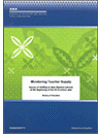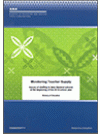The annual Survey of Staffing provides the Ministry of Education with a snapshot of the number of entitlement staffing vacancies at the start of Term 1. The survey also collects information about the number of overseas-trained and beginning teachers employed by schools. In 2014, the survey was completed by 92% of all state and state-integrated schools (94% of primary schools and 87% of secondary schools).
Key Results
Vacancies in state and state-integrated schools
There were 204.5 full-time teacher equivalent (FTTE) vacancies in state and state-integrated schools at the start of the 2014 school year. These vacancies represented 0.5% of all FTTE entitlement positions in such schools (0.4% in primary schools and 0.5% in secondary schools). Over the last ten years, the overall vacancy rate has varied between 0.9% and 0.4%.
As a proportion of entitlement positions, and consistent with previous years, vacancies were higher in schools in rural areas, schools with the highest proportion of Māori students on their roll (relative to other schools) and low decile schools (deciles 1–3).
Vacancies for Māori medium/bilingual teachers in primary schools
In primary schools, there were 13.1 FTTE vacancies for Māori medium/bilingual teachers, representing 0.6% of all FTTE entitlement positions in schools that offer Māori medium education. The proportion of vacancies for Māori medium/bilingual teachers in primary schools has been gradually increasing (0.5% in 2013, 0.4% in 2012 and 0.2% in 2011).
Vacancies for Pasifika medium/bilingual teachers in primary schools
At the start of Term 1 2014, there was one FTTE vacancy reported for a Samoan bilingual teacher, and no vacancies reported for Tongan or Cook Islands bilingual teachers. In 2013 there were no Pasifika bilingual vacancies in primary schools that offer Pasifika medium education.
Location of schools with vacancies
Consistent with data from previous years, the Ministry of Education local office areas of Invercargill, Nelson and Whangarei had the highest proportion of vacant entitlement positions.
Subject vacancies in secondary schools
Teaching positions in technology subjects made up the greatest proportion of vacancies in secondary schools (19.6% of all vacancies at the beginning of the 2014 school year, an increase from 13.3% in 2013). Half of these vacancies were in hard materials (for example, wood and metal work), and relatively few of them were in computer technology.
Mathematics and statistics had the second highest proportion of vacancies (15.7% of vacancies in secondary schools), followed by vacancies for English (14%), Māori language (Te Reo Māori and Māori medium/bilingual, 14%), and science subjects (8.3%). There were no vacancies reported for Pasifika medium/bilingual teachers. Past years’ data shows that English, Māori language, mathematics and statistics, and science subjects typically have the largest vacancy rates. A higher demand for teachers would be expected in the core subjects offered in secondary schools. Vacancies in technology subjects have fluctuated, with the rate in 2014 being a marked increase over that of 2013 (13%) and 2012 (5.2%).
Readvertised vacancies
In 2014, 29% of vacancies in primary schools (22% in 2013) and 47% of vacancies in secondary schools (41% in 2013) had been readvertised. There is anecdotal evidence that schools may choose to re-advertise vacancies to broaden their pool of applicants so care is required when considering these results.
Readvertised vacancies represented 0.1% of all FTTE entitlement positions in primary schools and 0.2% of such positions in secondary schools. The proportion of readvertised vacancies in schools has fluctuated over the last eight years, but in 2014 was half the proportion reported in 2006. Consistent with previous years, readvertised vacancies were higher in schools in rural areas, schools with the highest proportion of Māori students on their roll (relative to other schools) and low decile schools (deciles 1–3).
Relief teachers for positions that require proficiency in Te Reo Māori
In 2014, 14% of primary schools, and 62% of secondary schools had positions that require teachers to be proficient in Te Reo Māori. Overall, 66% of these principals reported finding it ‘very difficult’ to find relief teachers for positions that require proficiency in Te Reo Māori (66% of such primary and secondary schools). Thirty per cent of principals (29% of such primary schools and 31% of such secondary schools) reported finding it ‘somewhat difficult’ to source relief teachers for these positions. These figures are similar to those of 2013 and 2012.
New Zealand-trained applicants
Over the past three years, there has been an increase in the number of New Zealand-trained teachers applying for permanent positions in primary schools. Seventy-six per cent of primary schools had nine or more New Zealand-trained applicants for permanent Scale A classroom teacher position in 2014, compared to 73% of primary schools in 2013, 70% in 2012 and 59% in 2011.
In secondary schools, the number of New Zealand-trained applicants for positions has stayed relatively stable over the last three years. In 2014, schools were less likely to receive a high number of applications (nine or more) from New Zealand trained teachers for Te Reo Māori, Pasifika languages, the sciences and technology positions compared to other subjects – a trend that has been consistent over the last three years.
The proportion of schools receiving no New Zealand-trained applicants increased in 2014 compared to 2013 for Te Reo Māori, English, mathematics and statistics, physics, and technology, however, the actual numbers involved in such cases are quite small.
Overseas-trained teachers
Overall, the number of relatively new overseas teachers employed in state and state-integrated schools has declined over the last five years. Relatively new overseas-trained teachers in 2014 made up 0.4% of all teachers in primary schools (the same proportion as in 2012 and 2013) and 0.5% of all teachers in secondary schools (continuing the decline seen over the last five years).
Beginning teachers
Over the last five years, the percentage of first year beginning teachers (as a proportion of all teachers) has fluctuated. Overall, in 2014, first year beginning teachers made up 4.4% of all teachers (the highest proportion since 2010). First year beginning teachers comprised 4.9% of teachers in the primary sector (the same proportion as in 2013) and 3.7% of teachers in the secondary sector (up from 3.2% in 2013).


